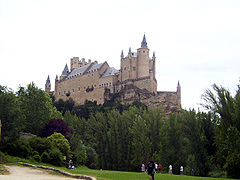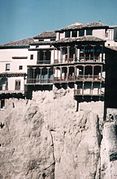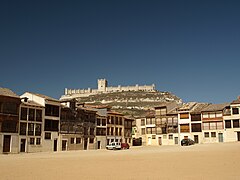Castile

Provinces of Old Castile: Burgos , Palencia , Valladolid , Ávila , Soria and Segovia ;
Provinces of New Castile: Madrid , Guadalajara , Toledo , Cuenca and Ciudad Real
hatched areas: Cantabria , La Rioja , León , Zamora , Salamanca and Albacete
Castile ( Spanish Castilla ) is a landscape located on the central plateau of Spain , the name of which goes back to the medieval kingdom of the same name . Its name, in turn, is based on the numerous castles (castillos) that still characterize the landscape today.
geography
Limits
Castile includes the present-day autonomous regions of Castile-La Mancha , the Autonomous Community of Madrid and most of Castile and León . East borders Castile to Aragon , north to La Rioja , Navarra , the Basque Country and Cantabria , on the west by the three former provinces of the Kingdom of León ( León , Zamora and Salamanca ), in the southwest on the for Estremadura belonging to the province of Cáceres and Mérida , to the south to Andalusia and to the south-east to the province of Albacete and the Valencian Community . Since Castile is no longer a separate political or administrative unit, the exact territorial scope cannot be clearly defined.
landscape
The up to 2500 m high Castilian divide immediately north of Madrid divides the 600 to 900 m high landscape (also called Iberian Meseta ) into the northern "Old Castile" and the southern "New Castile", which also includes the Mancha (from Arabic المنشرة al-manschara 'flat land').
Rivers
Castile has only a few larger rivers, all of which flow west into the Atlantic - the most important in "Old Castile" is the Duero , for "New Castile" the Tagus and Guadiana are important. They take in numerous smaller tributaries, some of which can dry out in summer.
Cities
- Old Castile
- Aranda de Duero (35,000), Ávila (60,000), Burgos (180,000), Palencia (80,000), Segovia (55,000), Soria (40,000), Valladolid (300,000)
- New Castile
- Ciudad Real (75,000), Cuenca (55,000), Guadalajara (85,000), Puertollano (50,000), Toledo (85,000)
- Autonomous Community of Madrid
- Madrid (3.2 million) plus approx. 10 cities with more than 100,000 inhabitants and approx. 10 other cities with more than 50,000 inhabitants
economy
Old and New Castile are agricultural landscapes of great spaciousness. Because of the low rainfall and the scarce irrigation possibilities, the yields are rather low compared to Central Europe. Not least because of this, viticulture plays a major role. Greater Madrid is one of the most important industrial centers in Spain and all of Europe. The domestic and European tourism has clearly gained in importance in the last decades of the 20th century.
language
According to this landscape, the Spanish language is often referred to as castellano ("Castilian"), especially to distinguish it from the other languages spoken in Spain , since the dialect that formed the basis of modern standard Spanish was and is spoken here.
history
Origins, name origin
Castile, the area of the upper Ebro , was called Bardulia until around 800 (after the tribe of the Bardulians who lived there ). The name Castile is first attested in a Latin document from the year 800, which speaks of a church in Territorio Castelle ("in Burgenland"). The region owes its name to the many forts (Latin castella , Spanish castillos ) that were built there to protect against attacks by the Arabs. The country was conquered in the 8th and 9th centuries by the kings of Asturias fighting against the Arabs and later belonged to his successor kingdom , the Kingdom of León .
Castile county
The kingdoms of Asturias and Leon let Castile be administered by local counts (see list of rulers of Castile ). These rose against the King of León around 925 and expanded the area to an independent rule, initially as an ally of the Caliph of Cordoba . Ferdinand González became the first, at times, independent Count of Castile. By revolts against the kings Ramiro II (931–950), Ordoño III. (950–957) and Sancho I (957–966) he sought to achieve the independence of his country from León.
His son García Fernandez also ruled almost independently until the year 1000. His son and successor Sancho bequeathed the rule to his son, Count García, and after his murder in 1026 it passed to Sancho's son-in-law, King Sancho Mayor of Navarre , on whose death in 1035 his son Ferdinand inherited Castile.
Kingdom of Castile and Crown of Castile
In 1037, Count Ferdinand of Castile conquered the kingdom of León and was crowned its king, thus reuniting León and Castile. For the short periods of 1065-1072 and 1175-1230, Castile was again separated from the Kingdom of León , but now as the Kingdom of Castile .
In 1230 the two kingdoms were finally united to form Castile-León. This empire is often referred to as the Crown of Castile, or simply Castile . In the further course of the Reconquista, it acquired extensive areas and, when it was completed (1492), comprised the north, center and south of the Iberian Peninsula. It bordered Portugal to the west and the territories of the Crown of Aragón and Navarre to the east .
Unification of Spain
Even after the unification of Spain by the Catholic Monarchs , the parts of the kingdom of the Crown of Castile - as well as the Crown of Aragon and Navarre - retained their own legal systems and institutions. First of all, it is purely a personal union . It was not until the beginning of the 18th century that the Bourbons turned Spain into a central state and largely extended the Castilian legal and administrative system to the other parts of the empire.
Modern administrative structure from 1833
The kingdoms associated with the Crown of Castile were divided into historical regions in 1833 as part of a territorial reorganization of Spain carried out by the Minister Javier de Burgos , which in turn was divided into provinces. This provincial division is still largely unchanged today. The provinces were grouped into "historical regions". Two of these had the name Castile in their name:
- Old Castile (Castilla la Vieja) : Santander (today: Cantabria ), Valladolid , Palencia , Burgos , Logroño (today: La Rioja ), Ávila , Segovia , Soria
- New Castile (Castilla la Nueva) : Madrid , Guadalajara , Toledo , Ciudad Real , Cuenca
However, the “historical regions” had no competencies or institutions of their own, they merely served to summarize different provinces.
This structure remains until 1975, with regionalization efforts being rigidly suppressed during the Franco dictatorship (1936 / 39-1975). In the phase of transition to democracy ( transición ), therefore, the issue of regionalization was one of the most pressing and most controversial issues. When discussing the future constitution, they agreed on a minimum compromise, which only provided a very broad framework for the later formation of "autonomous communities" (based on the existing provinces) and their competencies.
The result of the constitutional process of the Autonomous Communities in the Castilian territories gave the following picture:
- The peripheral provinces of Santander and Logroño, which had belonged to the “historical region” of Old Castile, formed their own uniprovincial autonomous communities as Cantabria and La Rioja, respectively.
- The remaining provinces of Old Castile together with the provinces of the "historical region" León ( León , Zamora , Salamanca ) formed the Autonomous Community of Castile-León ( Castilla y León ).
- The province of Madrid, which historically and geographically belongs to New Castile, also formed its own uniprovincial autonomous community.
- The remaining provinces of the "historical region" of New Castile together with the province of Albacete formed the Autonomous Community of Castile-La Mancha.
Since 1833 at the latest, Castile no longer exists as a separate political or administrative unit.
Today's Castile region
Castile is therefore only the name for a landscape today, the territorial extent of which is defined differently depending on the point of view, which applies in particular to the following areas:
- The current Autonomous Communities of Cantabria and La Rioja were historically part of the Kingdom of Castile. Geographically, however, they are beyond the peripheral mountains surrounding the Meseta (Cantabria on the Atlantic, La Rioja in the Ebro Basin).
- The provinces of León, Zamora and Salamanca (occasionally also Valladolid and Palencia) are sometimes viewed as a landscape of León that can be distinguished from Castile. From a historical point of view, this suggests that these areas always belonged to the Kingdom of León (or to the partial kingdom of León within the Crown of Castile) and never to the actual Kingdom of Castile, and also the southern part of the former Kingdom of León, Extremadura , did not come under “Castile “Is captured. In terms of landscape, however, Castile and León merge indistinguishably in the northern Meseta.
- Until the establishment of the province of Albacete in 1833, about half of its area belonged to the partial kingdom of Toledo (New Castile) and the partial kingdom of Murcia. In 1833 it was assigned to the "historical region" of Murcia. Today it belongs to the Autonomous Community of Castile-La Mancha.
Attractions
Due to its long history and its importance in the early modern period, Old Castile has an extraordinarily numerous and impressive historical sights - these range from the Romanesque churches and monasteries in the north (e.g. San Esteban de Gormaz ) to the Mudéjar churches in the southwest ( e.g. Cuéllar ). New Castile, on the other hand, mainly impresses with the buildings in Toledo .
Ávila City Walls
Alcázar of Segovia
Plaza Mayor of Salamanca
Burgos Cathedral
University of Alcalá de Henares
View over Toledo
Hanging houses in Cuenca
Peñafiel (Old Castile)
Consuegra windmills (New Castile)
See also
literature
- Gustav Faber: Madrid and Castile. Prestel 2000, ISBN 978-3-7913-2322-0 .
- José Jiménez Lozano: Castile: A spiritual journey through the heart of Spain. Paulusverlag 2005, ISBN 978-3-7228-0665-5 .
- Claudia Diemer: Reading tour Castile. Spain's magical center. Picus 2012, ISBN 978-3-7117-1016-1 .
- Hanspeter Burmeister and Felix Scheffler: Madrid and Central Spain. From the treasures of the Prado to the castles of Castile. DuMont 2013, ISBN 978-3-7701-3458-8 .














